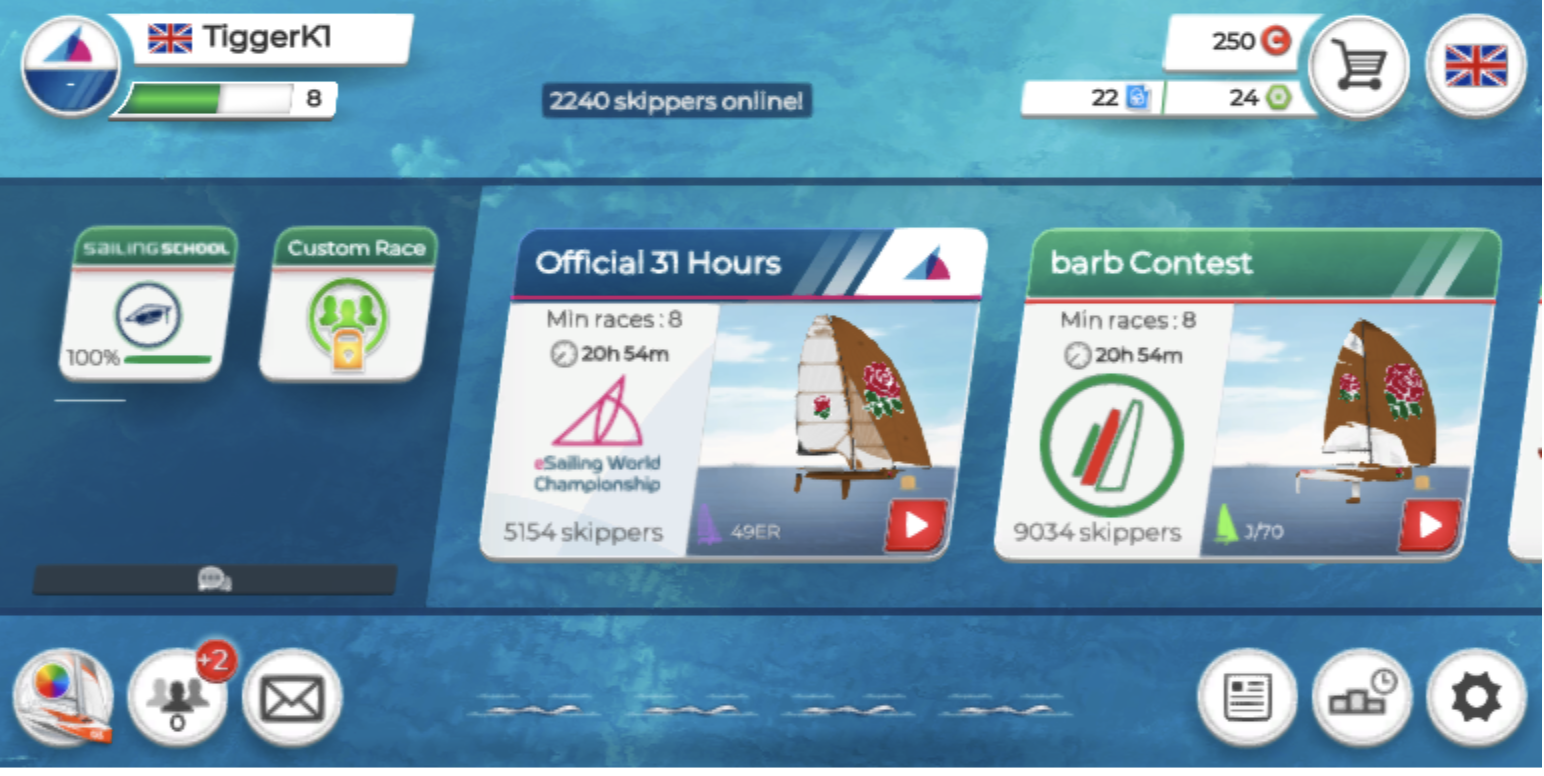Virtual Insanity is better than Lockdown Lunacy
Real sailing, of course, requires us to bring together many different skills and attributes such as boat preparation, handling skills, tactical decision making, finesse and tuning knowledge – which is what makes it such a challenging and rewarding sport.
Personally, among my many shortcomings, I lack the graceful balletic movement needed to caress a boat in light winds, the fitness to hike hard when it’s windy and the powers of observation to spot the difference a subtle tweak on the Cunningham has.
Luckily Virtual Regatta sailing requires none of this and focuses on the tactical and strategic decision making aspects of the sport. I find the strategies required are very similar to real sailing and the precise tactics vary depending on the boat being sailed, the wind strength and the size of the fleet.
The following advise assumes you have a basic familiarity with VR Regatta and summarises my opinion of what it takes to get near the front. Doubtless there are many hints still to learn!
General
Situational Awareness
Zoom out so you can see as much of the course as possible. Keep your head out the boat and look around at where the other boats are, how fast they are going and if you can cross them. Press on other boats to see their speed and lead.
Try and get a feel before the race how big and regular the shifts are.
Tacking
When tacking it can be quicker in some boats to bear away first to build speed up. This is particularly true for the Laser, J70 and AC75. Similarly I think there is merit in the AC75 in heading slightly high before gybing.
Boat Specifics
Know your boats potential performance. Some (like the Laser) go very much faster downwind than upwind, so bearing away to build speed before the start can be advantageous. Other, like the AC75, tack very slowly so manoeuvres should be minimised. The Offshore Racer can be pinched very high without much loss of speed to help shoot the windward mark. Penalties upwind in the Star will barely lose 3 boat lengths, downwind in the 49er a penalty is catastrophic.
Rules
The rules are similar but slightly different to proper sailing. Port tack rights at the windward Mark still confuse me, boats that are OCS continue to have rights and boats that gybe onto starboard don’t have to give a scintilla of opportunity to keep clear.
Assists
There are five “assists” that can be purchased via credits. The Best VMG is useful bordering on essential, the others don’t help much if at all. The Wind Intelligence can sometimes be useful if racing Stars as it shows the wind direction 30 seconds or so in the future, so you can tell if a header is on the way and try and position yourself on the outside of it, but the opportunity to make use of it is limited and therefore poor value.
Around the course
1. The start
It is really important to get a good start and that means hitting your favoured point on the line at t=0 at full speed. Anything less will leave in the pack fighting for clear air rather than being able to pick your route. Half a second at the start can easily become a 5 second loss and 3 or 4 places by the first mark.
If the start line is not exactly square (and it rarely is) then one end will be nearer to the windward mark than the other. All other things being equal this is the end you want to start. You can identify this end by looking at the overhead map and seeing which end the wind sock is pointing at or which end the dashed white line makes the smaller angle to the start line. In my experience the pin end is more often the favoured end by the time the start gun goes even if the committee boat end is looking good 30 secs before. Starting at the pin end also allows you to bear away for top speed prior crossing the line and potentially leebow your competition. The downside is that you can find yourself unable to tack onto port and forced out to or beyond the lay line, with dirty wind for half a beat. Therefore the final decision on where to start depends on how confident you are that the favoured end will still be the favoured end by the time you actually start and on how favoured it is. If the pin is only marginally favoured you may not get clear ahead to tack on to port and a more central position on the line may make sense.
Starting at the committee boat rarely seems to pay unless it is strongly biased that way. Winning the committee end is difficult to do without fouling or pointing too high to hit the line at speed.
2. The first beat
After the start do not foul anyone and keep clear air. This is much easier with a good start! Sail on the lifted tack if in a relatively slow boat (Laser, Star, J70) or in the strongest wind if in a fast boat (49er, Nacra). The slow boats do not go any faster in the gusts so the trick is to sail the shortest distance – this will mean trying to tack onto port as soon as possible if the pin end was the favoured starting position. The cats and skiffs accelerate with each gust, which seems to more than make up for being headed. A special case is the Laser, which actually slows down upwind once the wind is over 20kts. In this case Sail towards the lulls for better speed, or bear away to gain speed on a reach before quickly heading back up – your momentum means you carry the extra speed for long enough to overcome the extra distance of the zigzags.
Do not follow behind in another boat’s dirty air. Especially do not get leebowed by another boat, the loss is huge and you will be headed very badly, so well worth the two tacks to get clear. In the slow boats you get a nice lift if crossing behind another boat (on the opposite tack) but in the faster boats there is a significant speed loss from close crossing someone so it is best avoided.
Going left seems to pay more times than going right for the slower boats but the jury is out whether that holds for the faster ones.
3. The windward mark and spreader
If all has gone well you’ll be in the top two or three boat with a clear path round the mark and heading to the spreader mark. If the boat has a spinnaker, time the launch to coincide with reaching the spreader mark. This varies from boat to boat, but typically is about when you enter the three boat length circle. Figure out whether you want to gybe or just bear away – if you have clear air head for the most wind regardless of boat (they all go faster in more wind on the run), which is identified by dark water in the overhead view. If you are in a crowd it often pays to gybe round and head hard left to get clear air.
If the first beat was less than ideal my top tip is to avoid the starboard lay line and instead approach the mark on port. Don’t worry about hitting any boats as you tack round it, just accept the penalty and bear off to get the inside line at the gybe mark. This will lose you less time and distance than being good and waiting your turn, but don’t try this move for real once lockdown ends!
4. The first run
Look for wind and don’t let anyone blanket you, but try not to get caught in a luffing match. It is better at this stage to try and pull away from the pack even if you are second or third than fight tooth and nail to overtake the boat ahead. This can involve going off the rhumb line in the Star or Laser, usually to the left so that you can later gybe on to starboard with rights.
Do not hit the right layline in the asymmetrics; you will be blanketed and have no rights.
5. The leeward mark
Decide which Mark you want (the most upwind one!) and don’t get bounced onto the other one. It often pays to tack right round the mark, especially in the faster boats, as you have good speed going into the tack.
6. The second beat
If things are going well now is the time to defend by covering and minimising any leverage the opposition can get. This beat is shorter than the first so there is less to be lost by being on the headed tack if it means staying in phase with your nearest rival.
7. The windward and spreader mark
As before, but hopefully less congested!
8. The final run
If you are 80m or so ahead you are safe as you are out of any dirty wind from following boats, so sail straight to the nearest end of the finish line and smile as you cross it! Otherwise you want to get to the left of other boats you are defending or attacking – unless there is notably more or clearer wind on the right. This way if they draw level you can gybe onto starboard and win a penalty either through a port/starboard collision or the windward boat failing to keep clear. This is especially useful in the slower boats which can be severely blanketed by boats behind making defence otherwise quite tricky. Never put yourself in a position immediately to the right of another boat, you are a sitting duck to have a foul put on you.
Summary
- Start well
- Stay out of trouble up first beat, take lifts if in slow boat or gusts if fast.
- Avoid hitting lay lines early, especially the starboard one.
- Get inside at windward mark en route to spreader, even if that means taking a penalty, especially in slow boat, otherwise you will be forced right downwind with very few rights or means of protecting air.
- Try to keep clear air on first downwind – stretch legs and avoid luffing battles. Flight not fight at this stage.
- Plan which leeward mark to take – the most upwind one!
- On second beat, minimise leverage if defending, maximise if attacking.
- Defend or attack aggressively on last run – keep left to get right of way, or very hard right if cleanest air.
- Enjoy, learn and try and do better every race!
Toby Peacock

